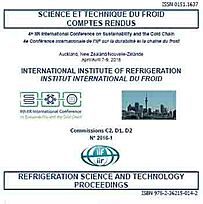
IIR document
Effect of supercooling on the cutting of frozen Atlantic salmon (salmo salar) fillet.
Author(s) : LEE Y. J., WATANABE M., SUZUKI T.
Summary
Supercooling is the process of lowering the temperature of a product below its initial freezing point without phase change. It is known that existence of supercooling state before freezing has significant influence on the structure of ice crystals. Automated cutting of salmon fillets is usually made in the partially frozen state. It would be expected that the partial freezing experiencing supercooling state improved the cutting process. The objective of this study was to evaluate the effect of supercooling before freezing (supercooling-freezing, abbreviated as SF) on the cutting of salmon fillet. The cutting test was conducted by using a texture analyzer. Samples were compressed to a 90 % strain with a knife probe. The maximum force was used for describing the cutting force. The microstructure was observed using light microscope. Our results showed that SF had influence on the microstructure and cutting force. The microstructure of SF sample showed less damaged cells than normal freezing. The cutting force for SF sample was lower than that for normally frozen salmon. In addition, there was no significant difference between the cutting forces for raw and SF samples.
Available documents
Format PDF
Pages: 8
Available
Public price
20 €
Member price*
Free
* Best rate depending on membership category (see the detailed benefits of individual and corporate memberships).
Details
- Original title: Effect of supercooling on the cutting of frozen Atlantic salmon (salmo salar) fillet.
- Record ID : 30017548
- Languages: English
- Source: 4th IIR International Conference on Sustainability and the Cold Chain. Proceedings: Auckland, New Zealand, April 7-9, 2016.
- Publication date: 2016/04/07
- DOI: http://dx.doi.org/10.18462/iir.iccc.2016.0002
Links
See other articles from the proceedings (63)
See the conference proceedings
Indexing
-
Themes:
Freezing of foodstuffs;
Fish and fish product - Keywords: Structure; Cutting (action); Supercooling; Salmon; Process; Freezing
-
Influence of fish freshness on the freezing pro...
- Author(s) : OZEKI A., WATANABE M., SUZUKI T.
- Date : 2020/08/26
- Languages : English
- Source: 6th IIR International Conference on Sustainability and the Cold Chain. Proceedings: Nantes, France, August 26-28 2020
- Formats : Video, PDF
View record
-
Improving energy efficiency in seafood freezing...
- Author(s) : SVENDSEN E. S., INDERGÅRD E., BENGSCH J., WIDELL K. N., KOSTER L., NORDTVEDT T. S.
- Date : 2024/06/11
- Languages : English
- Source: 8th IIR International Conference on Sustainability and the Cold Chain. Proceedings: June 9-11 2024
- Formats : PDF
View record
-
A preventive method of colour deterioration of ...
- Author(s) : HIRAOKA Y., OHSAKA E., NARITA K., et al.
- Date : 2003/08/17
- Languages : English
- Source: 21st IIR International Congress of Refrigeration: Serving the Needs of Mankind.
- Formats : PDF
View record
-
Chilled and frozen Atlantic salmon: Environment...
- Author(s) : REDO M. A., CHE M., WATANABE M., TOLSTOREBROV I.
- Date : 2024/06/11
- Languages : English
- Source: 8th IIR International Conference on Sustainability and the Cold Chain. Proceedings: June 9-11 2024
- Formats : PDF
View record
-
Handling, processing and freezing of pelagic fi...
- Author(s) : NORDTVEDT T. S., STAVSET O., WIDELL K. N.
- Date : 2015/04/16
- Languages : English
- Source: 6th Conference on Ammonia and CO2 Refrigeration Technology. Proceedings: Ohrid, North Macedonia, April 16-18, 2015.
- Formats : PDF
View record
